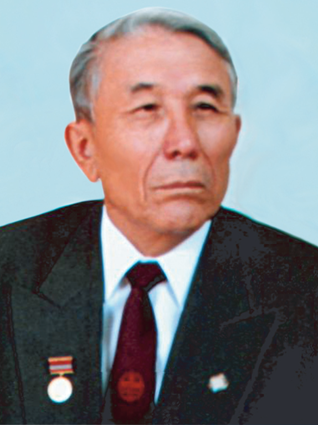
Geological engineer, candidate (1967) and doctor (1990) of geological and mineralogical sciences, laureate of the State Prize of the Kazakh SSR (1982), professor (1999), corresponding member (1994), academician (2003) of the National Academy of Sciences of the Republic of Kazakhstan, distinguished exploration geologist of Kazakhstan (2002), academician of the Academy of Engineering Sciences of the Republic of Kazakhstan (2003), head of the regional geology laboratory at the K.I. Satpaev Institute of Geological Sciences. A full member of the Cambrian Subcommission of the UNESCO International Union of Geologists (since 1990).
Born on October 17, 1932, in the village of Kamysta, Zhanybek District, West Kazakhstan Region. In 1951, he graduated from a Kazakh secondary school in the village of Zhanybek and entered the S.M. Kirov Kazakh State University's economics faculty the same year, where he studied for the first semester before transferring to the geological department of the geological-geographical faculty in 1952.
During his studies until graduation in 1956, he attended all theoretical and practical classes at KazSU daily and passed all exams and credits with "good" and "excellent" grades. He actively participated in the faculty's public life: he was elected a member of the Komsomol committee bureau, constantly participated in faculty and university Spartakiads. He especially noted the associate professors K.N. Yerzhanov, A.I. Repin, V.A. Sokolov, and V.F. Bespalov among the teachers. Their lectures were substantive, accessible, with practical examples from geology.
He underwent practical training after the 3rd and 4th courses in field expeditionary works of the K.I. Satpaev Institute of Geological Sciences of the Academy of Sciences of the Kazakh SSR on the topic of regional geology and Paleozoic stratigraphy of the northeast of Central Kazakhstan, supervised by Academician R.A. Borukaev. His direct mentor at the Alexandrovsk polymetallic deposit and the adjacent territory of Bayanauyl District, Pavlodar Region, was Candidate of Geological-Mineralogical Sciences V.S. Zvoncov. He was personally invited to the Institute of Geological Sciences by Kanyshe Imanbayevich Satpaev on the recommendation of R.A. Borukaev and V.S. Zvoncov.
From 1956 to 1960, he participated in the state geological survey and thematic works in the north and northeast of Kazakhstan. He contributed to the compilation of two State Geological Maps of the USSR at a scale of 1:200,000, as well as working versions of geological maps of the same scale, sheets of the Kyrkauyduk array, and the Arkalyk-Tundyk area, which subsequently formed the basis of the State Geological Map. He studied the Lower Cambrian (Edrian) and Middle Ordovician (Llandovery) sections, which became the subject of many subsequent studies and also later became reference points.
From 1960 to 1967, he studied the stratigraphy and biostratigraphy of "silent" Cambrian deposits of the Southern Ulytau and the Bolshoi Karatau Ridge. As a result, a scheme for zoning the Middle-Upper Cambrian and Lower Ordovician deposits of these regions was developed, contributing to the differentiation of Cambrian and Precambrian deposits within this vast territory and, for the first time, to the identification of the Vendian. Based on the fauna, a regular change in sliding age (Willer-Visler or Golovkinsky principle) of shale and carbonate facies (suite) was established.
From 1968 to 1992, he systematically studied the stratigraphy and trilobite fauna of Cambrian and Tremadoc deposits of the Karatau Ridge, especially the Small Karatau. As a result, he developed, for the first time, a three-tier division of the Upper Cambrian deposits for the territory of the former Soviet Union. Based on the fauna, he definitively established the Lower Cambrian age of phosphorite beds. He proposed a stratigraphic scheme for Cambrian deposits of the Karatau type sections of Kazakhstan and Kyrgyzstan as the basis for dividing Cambrian deposits of Central Asia. During these years, he also studied Precambrian and Lower Paleozoic beds of the Or-Ilek Zone of the Mugodzhary, where he managed to clearly delineate the sections of the mentioned beds and faunistically prove the wide development of the Kidryassov suite of the Upper Cambrian and Lower Ordovician, compile a schematic map of the Or-Ilek anticline.
Since 1995, he conducted research on stratigraphy, regional geology, and surveying in the territory of the former Semipalatinsk nuclear test site. He directly supervised and participated in the compilation of the first geological map of the test site (1997) at a scale of 1:200,000 with an explanatory note, which presents modern data on the stratigraphy of Paleozoic deposits.
Studies in the field of stratigraphy and corresponding trilobite fauna are of paramount scientific and practical importance in Kazakhstan. Karatau has become one of the classic sites where Cambrian deposits have become an international polygon, which was visited by scientists from 40 countries during three international excursions in 1984 and 1990. The conviction of specialists from many countries contributed to the establishment of the Aksai State Geological Reserve, in the section of which there are more than ten groups of invertebrate fauna and which serves as the stratotype for six tiers and 22 zones of the Middle and Upper Cambrian. The Middle and Upper Cambrian scale, compiled with centimeter accuracy, should remain unchanged for many years, as it includes eight chronozone proposed by the International Stratigraphic Cambrian Subcommission of the International Union of Geological Sciences (ISCS) under UNESCO.
The initiative of G.K. Ergaliev in organizing international excursions, conducting joint work with scientists from the USA, England, Sweden, and Poland (1992-1995) to promote the achievements of geological science in Kazakhstan is well known. His works were published in the materials of the 13th International Geological Congresses and Symposia. He has published over 250 scientific works, including two monographs, five guidebooks, and 12 articles in English. He is a co-author of two published State Geological Maps of the USSR at a scale of 1:200,000, five paleotectonic maps of the USSR at a scale of 1:5,000,000, special geological maps of Central Kazakhstan, the Karatau ridge, and the territory of the Semipalatinsk nuclear test site at a scale of 1:200,000, and numerous archival manuscript reports. He is one of the active authors of the Kazakh Soviet and then National Encyclopedia of Kazakhstan. Under the editorship of G.K. Ergaliev, summary works were published: "The Pre-Paleozoic and Paleozoic of Kazakhstan" (1971); "Stratigraphy and Paleontology of the Lower Paleozoic of Kazakhstan" (1983); "Geology and Metallogeny of Karatau" (1986) and "Atlas of Key Stratigraphic Sections of the Phanerozoic of Kazakhstan" (2008).
Other news


